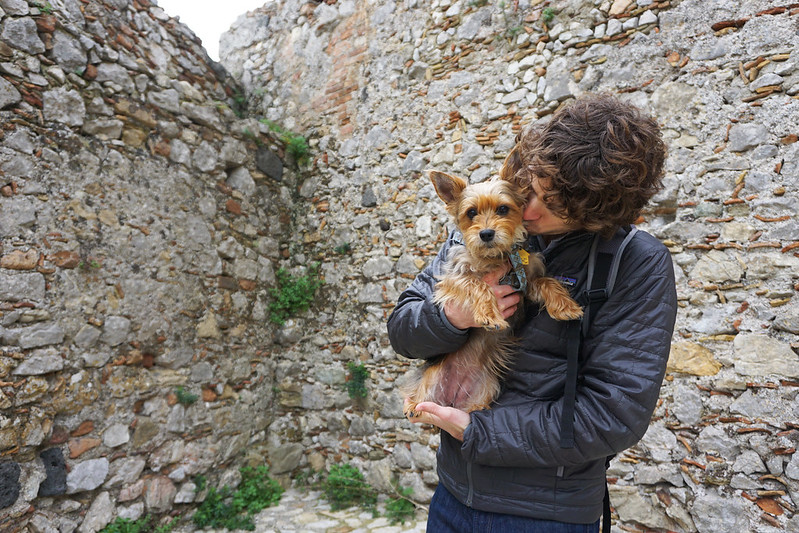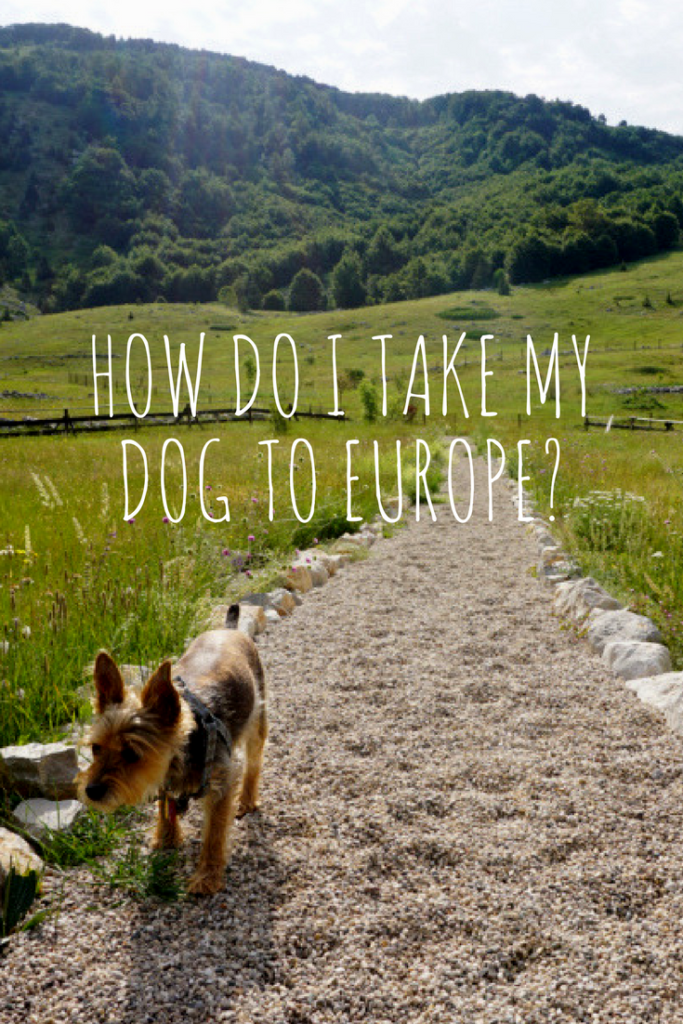Ask Me Anything: How Do I Take My Dog to Europe?
Welcome to Ask Me Anything—a new series here on the blog where I invite you to send me your questions (anything from dog travel to freelancing to “where should I go on my trip?”) and I do my best to answer based on six years of full-time travel experience, 15 years as a writer, and seven years as a freelancer.
Have a pressing question? Send it over.
And now, today’s question:
Please talk about getting a dog into Europe (reality of what paperwork needed versus what we can read about) and mostly though about finding lodging/taxis, etc. with a dog. Thanks. – Kate
Let’s start by talking about paperwork.
First, it’s important to note that the requirements for taking a dog to Europe vary depending on where you’re coming from. Taking a dog from South Africa to Italy is a very different thing than taking a dog from the US or Canada.
For the purposes of this answer, I’ll assume you’re asking about the requirements for going from the US to Europe. But if you’re coming from somewhere else, know that you’ll need to do a little more research. Countries with a high rabies risk require a different set of paperwork and may require quarantine.
For those going from US to Europe (or Canada to Europe), the first step is to get your dog microchipped with an international standard microchip. Luna’s is via HomeAgain. The vet inserts the microchip into your dog’s neck in a super quick, easy out-patient procedure. You’ll need to do this ahead of time because the microchip insert has to happen before the most recent rabies shot.

Next, you’ll need to get your dog a rabies shot. Every European country I’ve flown into recognizes the three-year rabies vaccine (with the exception of the UK), but it’s always good to check. Some parts of the world only recognize rabies vaccines for a single year before requiring a booster. When you get your rabies certificate from the vet, ask for a second copy and have the vet hand-sign both copies. It’s not always necessary, but it never hurts to have a backup and have both signed.
This needs to happen at least four weeks before you head to Europe, so plan ahead.
Your dog should also be up-to-date on his other essential vaccinations (DHLPP), so when you get the rabies booster, check with your vet to make sure you’re totally up to date.
Once you have those two things (microchip and vaccinations), for most countries (with the exception of UK, Sweden, and Norway), it just comes down to paperwork, which has to be completed by your vet usually within 10 days of travel.
Make an appointment at a USDA-certified vet (you can call your vet and ask if they’re USDA certified) and tell them where you’ll be arriving. If your first stop is Italy, they’ll have to fill out the health forms with Italian/English and if you’re stopping first in France, you’ll need the French/English form. Your USDA-certified vet should know where to get the latest forms. If not, you probably need to call a different vet.

Ask your vet to email you the paperwork so that you can make sure you have all the details he or she needs to fill in. It’ll be things like the date of your last rabies vaccine, the import address (where you’ll be staying when you arrive in Europe), the export address (your home address), etc.
Once the paperwork is all filled out, you’ll need to take it to your local USDA veterinary office for approval and a stamp. Before you make your vet appointment, it’s a good idea to call your local office and ask about their process–because each one is a little different. I’ve been to offices that dealt with pet paperwork on a first-come, first-served basis between certain hours and also dealt with offices that required an appointment. They all charge a fee and some only accept cash while others take checks. Some may allow you to send your paperwork by mail. It’s always a good idea to check with your specific office ahead of time.
Once you have your papers stamped by the USDA, make copies (to keep safe in your other bag) and keep the original copy and one of the original copies of your rabies certificates on hand for travel. This is what customs will want to see when you arrive in Europe.

For most European countries, that’s it.
Microchip. Up-to-date vaccines. Paperwork filled out by your vet and stamped by the USDA within 10 days of travel.
It can sound daunting, but it’s actually not too tricky. That said, do make sure to check the requirements for the specific country you’re visiting, as a couple European countries (most notably the UK, Sweden, and Norway) have additional requirements.
Now, once you have a good understanding of the paperwork, the other thing you’ll need to do is figure out flights. Not every airline accepts dogs and all the airlines have somewhat different rules. Before you book a flight, check with your airline of choice to find out:
:: Do they allow dogs?
:: Do they allow small dogs in cabin?
:: If so, what’s the maximum weight allowed in cabin (and is that for the dog or the dog + carrier)?
:: What are their requirements for dog carriers?
:: How many in-cabin dogs are allowed on your flight? Is there space for your pooch? Can you book the dog ahead?
If you’re traveling with a dog too large to travel in cabin, you’ll need to know about carrier requirements for the hold, whether they have space for your dog, and how good their reputation is for transporting animals.

Now, to the second part of your question: Once you arrive in Europe, traveling with a dog is crazy easy.
Most trains and buses are dog-friendly (though you’ll need to check requirements by country; some may require a muzzle for your dog to travel on public transport and others may require you to buy your dog a special ticket). I’ve heard of people with larger dogs having trouble finding a dog-friendly taxi, but I’ve never personally had a taxi take issue with Luna (though she’s small and rides in my lap or her carrier).
For accommodations, I simply ask before I book. Can you take a small, non-shedding, therapy-trained pooch? A good 90% of the time, the answer is yes.
Dogs are also welcome in shops, cafes, restaurants, bars, and parks in most of Europe. Just watch for no-dogs signs and respect those when you see them (which isn’t often).

The big exceptions to this dog-friendly culture are Spain, the UK, and Bosnia and Herzegovina. These places tend to run much less dog-friendly (though in some ways still more dog-friendly than the US). UK doesn’t allow dogs in restaurants. Spain’s buses will force you to put Fido in the baggage area (uh, no, Spain. So much no.). And in Bosnia expect strangers to (very rudely) stomp their feet at your dog and jump theatrically away from her as she walks down the street.
But those are exceptions to the rule. And the rule in Europe is this:
Dogs welcome.
Have a question about dogs in Europe? Toss it in the comments.
Have another question you’d like to have me tackle? Let me know.

Going to Europe?
Check out my series of local-centric guidebooks.



Comments
-
-
Kate Green
This is awesome and exactly the information and support I was hoping for. THANKS so much. We are heading to Europe in March with Darwin the beagle so planning now:)
Kate
-
-
Deb
I acquired my Scottish Terrier in Spain. You are right, Spain is not so open to dogs, but a little better on the northern coast. I’ve alwys been able to find apartments and hotels to take us. I was able to travel by train with her in a carrier under the seat. (there is less space in seats facing each other so book accordingly.) We also travelled as foot passenger on a ferry between Barcelona and Italy. Rules said she had to wear a muzzle on deck and stay in their kennel for which I reserved and paid for. But once I got on board those restrictions were not expected. The porter escorted us to our stateroom and said she could stay there.
I wanted to take a bus from Trieste Spain to Zagreb Croatia but they wouldn’t accept a dog so I ended up with a $200 car service.My dog is just over the weight limit for in cabin plane travel. Do you know if airlines are likely to weigh the dog and crate?
-
Ellen
We live in London and fly fairly frequently with our dog. I’ve flown with him on Brussels and Swiss and the impression I get from people is that most, if not all, European airlines will weigh the dog. United doesn’t if you are traveling trans-atlantic. I’ve heard Norwegian honors emotional support animals even for intra-Europe flights.
PS If you are ever in the UK again, you can have dogs in restaurants. The health code simply prevents dogs from being in food preparation areas. That being said, dogs are more readily accepted in pubs, coffee shops, cafes, and other casual restaurants. Unlike Italy, the prevalent culture is that dogs (and children) shouldn’t go out for nice meals. However, in London, you can bring them into fancier places depending on the neighborhood. There is a 1 michelin star Italian restaurant that is dog friendly. And in our neighborhood in London the majority of restaurants are dog friendly.
-
-
Jadeloft
I had to jump through extra hoops (Rabies teter test & waiting 4 months before being him) to bring my dog to live with me in Hawaii so going to Europe from Hawaii seems daunting. His chip is not ISO so would I need to get him a second chip? Also, he just got his 3yr Rabies shot last year so it’s still valid two more years however would he need another shot simply because it must be given after he gets this new ISO chip? If so I hope it’s safe to do so. I also hope there’s a USDA vet in Honolulu?!
I’d have to fly HNL to LAX, then LAX to CDG. My dog is chihuahua/minpin and around 10-11lbs. If he’s not allowed in the cabin for that 12 hr flight then I’d have to think twice about taking him. Then again could he hold his pee 12 hours?! Doubt it. Also have a soft side carrier for in cabin but he’s a bit tall – wonder if most airlines would be stickers about height? I mean he could lay comfortably and stand and turn but he’d most likely be ducking his head.
Again, traveling with my dog seems daunting. Sigh.
-
Dayna
Hello, there is another option to the non-ISO microchip: you can bring your own scanner on your travels (which may not be affordable?). I would definitely prefer to an extra rabies booster/chip…but just now researching scanner cost and it was pointed out that if your pet gets lost in another country, facilities would not have the scanners to read your non-ISO chip, so that’s good information.
A Croatian vet just told me Croatia has a one year rabies rule (not honoring the 3 year), but that that would change soon.
I am still trying to figure out if Bosnia & Herzegovina is a high risk rabies or not, if necessary to do titers before a quick trip, returning back into Croatia. The rabies titer test was quoted to me at 500kn, which is about $77USD right now, ouch. I see Bosnia listed different places as both a controlled rabies country and a high risk country (with Montenegro always high risk). Gigi, do you know if rabies titers are necessary if you travel back to EU from Bosnia? And is that about what you paid for Luna’s titer test?
-
-
Gillian Batt
Hi Gigi, love your blog – great source of inspiration for our upcoming travels.
We will soon be slow travelling Europe and beyond with our two toy poodles, moving through EU and non EU countries (Balkans, Turkey, Morocco). This “trip” will last a few years a least.
Microchip, rabies vaccination and titre (after 1 mo) will all be done 3 months ahead. I will plan to get them pet passports in our first EU country but I’m wondering about moving back and forth between EU and non-EU countries. Could you confirm that they will need vet certificate for each country, signed within 10 days of travel? If so it seems like we will spend a lot of time (and money) making trips to the vet in each country. If there is any way around this do let me know! Thanks a lot for your advice.
Cheers,
GillianP.S. We will not be visiting those countries with additional requirements such as UK, Norway etc.
-
Jake Norton
Hi Gillian & Gigi,
Wondering how your trip is going and especially how your crossings in and out of the EU have been?
We’re planning a shorter trip, about 3-4 months, this summer/autumn. We have been planning to spend a bit of time in Bosnia and perhaps Montenegro, but it seems the latter is not possible due to the rabies risk and difficulty of returning to the EU afterward with our dog?
If you have time, I’d love to hear your thoughts and experiences. Our plan is landing in Germany, traveling for a couple weeks south through Germany and Austria to Slovenia where we’ll stay for all of September. From there, we’ll head to Croatia, Bosnia, (maybe Montenegro, but doubtful now), and then back up through Hungary to Romania and Bulgaria before returning to Schengen and crossing Europe to depart from Spain eventually.
Thanks in advance for any thoughts you have, and looking forward to your reply! Hope the travels are going well!
Best,
Jake
-
-
Kolten
Thanks for the inclusive list. I had no idea that there was an international microchip for pets. Trying to get all paperwork done could be such a mad dash.
-
Jennifer
Hello, We are moving to Europe indefinitely in January 2022 with our French Bulldog. We are not getting visas and plan to do the first three years hopping between Italy, Croatia, and Bosnia. We will get our Frenchie an EU pet passport in Italy when we arrive. My concern is about traveling between Croatia and Bosnia. I understand that Bosnia recognizes the pet passport but have read that you must cross at certain check points. Has that been your experience? Have you had any issues crossing the border between Croatia and Bosnia with your pup? Thank you!

Pamela
One of my dreams is to take my dog to Europe. It’s one reason I bought a bluewater sailboat. Unfortunately she has defeated me by refusing to eliminate on board.
But I still live in hope that I’ll get to use this info someday. 😉